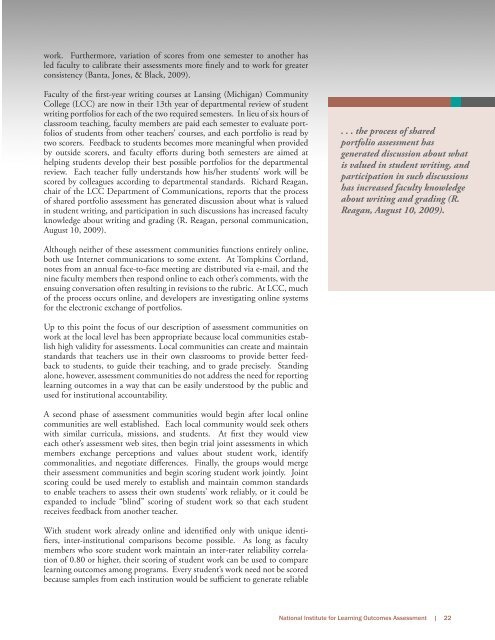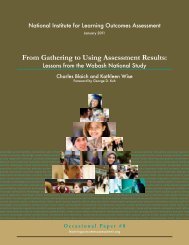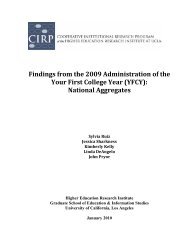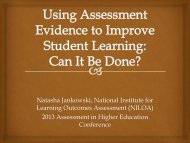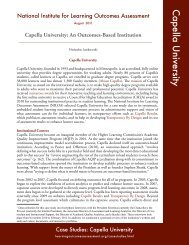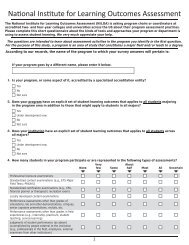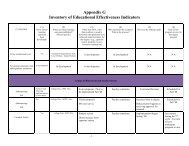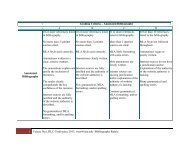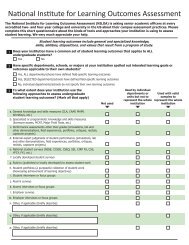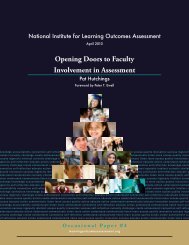Three Promising Alternatives for Assessing College - National ...
Three Promising Alternatives for Assessing College - National ...
Three Promising Alternatives for Assessing College - National ...
- No tags were found...
You also want an ePaper? Increase the reach of your titles
YUMPU automatically turns print PDFs into web optimized ePapers that Google loves.
work. Furthermore, variation of scores from one semester to another hasled faculty to calibrate their assessments more finely and to work <strong>for</strong> greaterconsistency (Banta, Jones, & Black, 2009).Faculty of the first-year writing courses at Lansing (Michigan) Community<strong>College</strong> (LCC) are now in their 13th year of departmental review of studentwriting portfolios <strong>for</strong> each of the two required semesters. In lieu of six hours ofclassroom teaching, faculty members are paid each semester to evaluate portfoliosof students from other teachers’ courses, and each portfolio is read bytwo scorers. Feedback to students becomes more meaningful when providedby outside scorers, and faculty ef<strong>for</strong>ts during both semesters are aimed athelping students develop their best possible portfolios <strong>for</strong> the departmentalreview. Each teacher fully understands how his/her students’ work will bescored by colleagues according to departmental standards. Richard Reagan,chair of the LCC Department of Communications, reports that the processof shared portfolio assessment has generated discussion about what is valuedin student writing, and participation in such discussions has increased facultyknowledge about writing and grading (R. Reagan, personal communication,August 10, 2009).. . . the process of sharedportfolio assessment hasgenerated discussion about whatis valued in student writing, andparticipation in such discussionshas increased faculty knowledgeabout writing and grading (R.Reagan, August 10, 2009).Although neither of these assessment communities functions entirely online,both use Internet communications to some extent. At Tompkins Cortland,notes from an annual face-to-face meeting are distributed via e-mail, and thenine faculty members then respond online to each other’s comments, with theensuing conversation often resulting in revisions to the rubric. At LCC, muchof the process occurs online, and developers are investigating online systems<strong>for</strong> the electronic exchange of portfolios.Up to this point the focus of our description of assessment communities onwork at the local level has been appropriate because local communities establishhigh validity <strong>for</strong> assessments. Local communities can create and maintainstandards that teachers use in their own classrooms to provide better feedbackto students, to guide their teaching, and to grade precisely. Standingalone, however, assessment communities do not address the need <strong>for</strong> reportinglearning outcomes in a way that can be easily understood by the public andused <strong>for</strong> institutional accountability.A second phase of assessment communities would begin after local onlinecommunities are well established. Each local community would seek otherswith similar curricula, missions, and students. At first they would vieweach other’s assessment web sites, then begin trial joint assessments in whichmembers exchange perceptions and values about student work, identifycommonalities, and negotiate differences. Finally, the groups would mergetheir assessment communities and begin scoring student work jointly. Jointscoring could be used merely to establish and maintain common standardsto enable teachers to assess their own students’ work reliably, or it could beexpanded to include “blind” scoring of student work so that each studentreceives feedback from another teacher.With student work already online and identified only with unique identifiers,inter-institutional comparisons become possible. As long as facultymembers who score student work maintain an inter-rater reliability correlationof 0.80 or higher, their scoring of student work can be used to comparelearning outcomes among programs. Every student’s work need not be scoredbecause samples from each institution would be sufficient to generate reliable<strong>National</strong> Institute <strong>for</strong> Learning Outcomes Assessment | 22


